Hands On with USB Type C: Reversible USB Connectors
by Joshua Ho on September 11, 2014 9:00 AM EST- Posted in
- Smartphones
- Mobile
- Laptops
- Tablets
- USB-IF
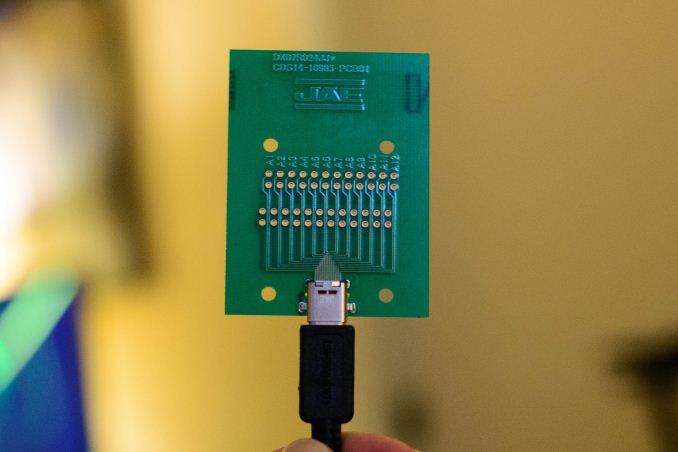
Today, the USB-IF brought me in to see the long-awaited USB Type C cables. We've written about this before, but for those that aren't familiar with this new USB spec, the USB Type C cable and USB 3.1 spec are designed with the future in mind. As a result, there are a lot of new features to talk about. We'll start with the USB 3.1 spec before we get into the Type C connector.
With USB 3.1, we see a few key improvements. Peak throughput goes to 10 Gbps from 5 Gbps, which translates to a peak of 1.25 GB/sec. In a demo of an early controller with two SSDs attached to the system I saw peak throughput of 833 MB/sec. As a side note, I also saw a demo of wireless USB connectivity from smartphone to laptop and laptop to smartphone, which was definitely pretty cool. Getting back to the USB 3.1 spec, USB Power Delivery 2.0 (PD) makes it possible for USB to supply up to 100 watts, and coexists with the BC 1.2 spec that is used in USB power adapters to charge phones so a single port would be able to provide power for both systems. In addition, USB PD 2.0 allows for power to go both ways without changing the direction of the cable, so a laptop would be able to send and receive power from the same port. Finally, USB Type-C extensions mean that it's possible to do all kinds of interesting applications over USB ports, such as sending audio and video data. It's even possible for a USB Type C port to send PCI-E data through the connection for use cases such as a two in one convertible tablet.
This opens up the possibility for a dock scenario where a single cable to the monitor can charge a laptop and also mirror the laptop's display onto the external monitor, and the external monitor would also be able to serve as a USB hub for a keyboard, mouse, headsets, flash drives, and other USB peripherals. While the laptop charging aspect and integrated USB hub in display wasn't demonstrated in the prototype I saw, everything else was fully working as shown in the photo above.
I was also able to get some photos of the cable and receptacle. Unfortunately it took flash to really show the detail in the connector but it definitely will be a great standard for all kinds of applications. While I'm sure that there will be differences in the final product, the reversible plug works just like expected and could be quickly inserted from behind the back. The USB-IF believes that this standard will show up in products shipping in 2015. It does seem that the connector is a bit less compact than microUSB, but the benefits outweigh this increase in size.


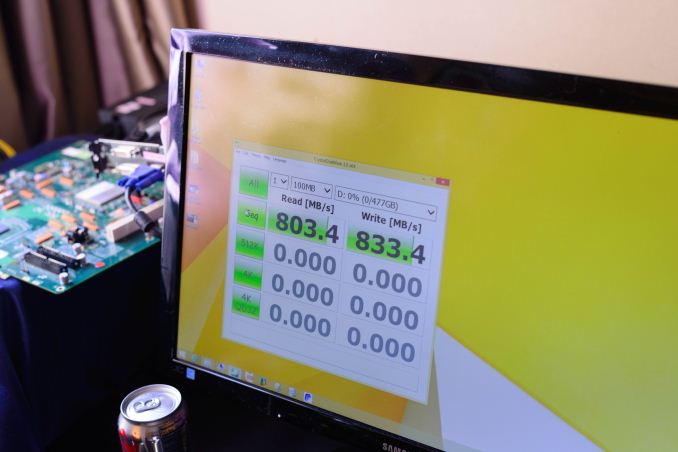
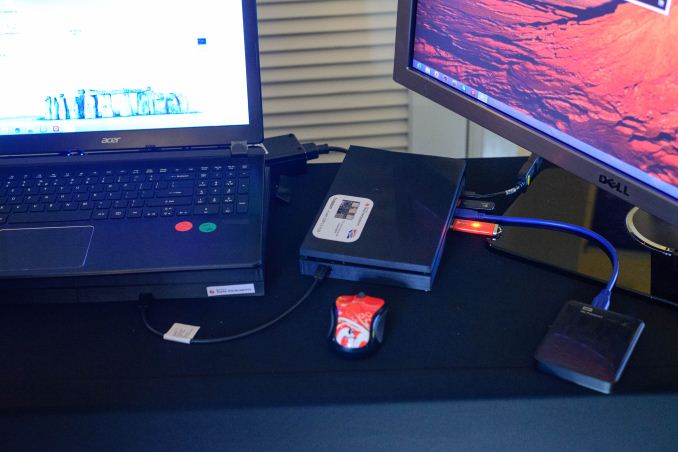
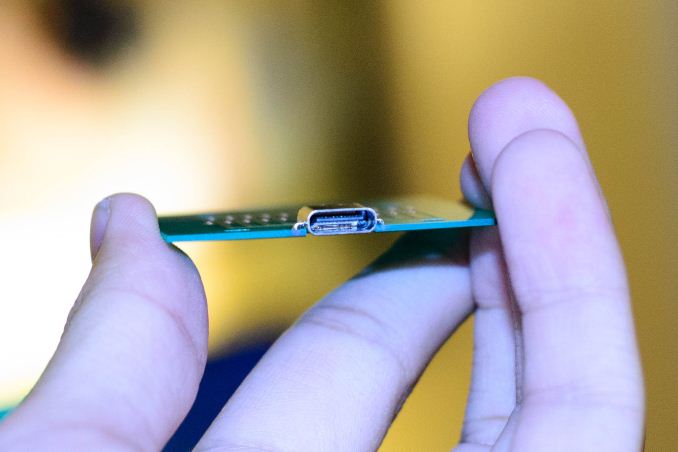
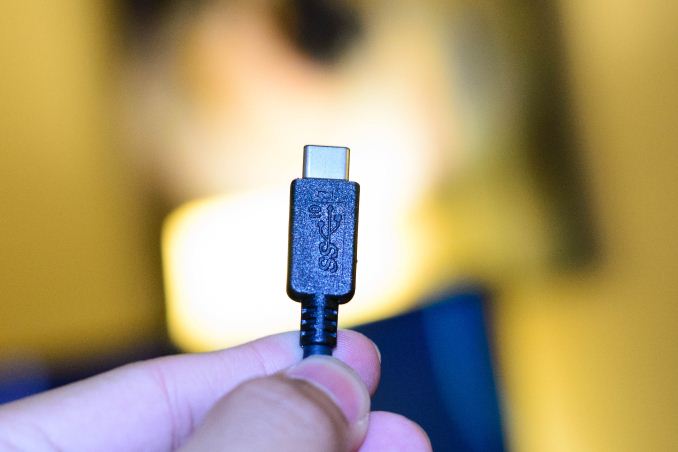
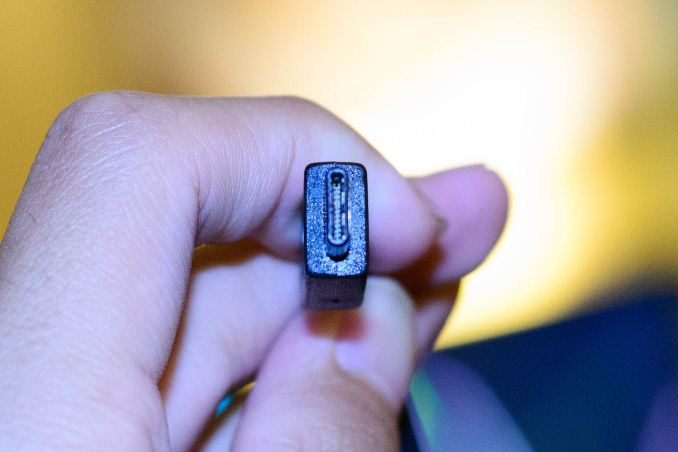








91 Comments
View All Comments
van2 - Tuesday, March 10, 2015 - link
Yes! Still waiting for a small connector as reliable as magsafe. We have seen many of the micro-usb jacks and cables quickly become broke or worse yet, intermittent, because they are just not sturdy enough. Worst case scenario is the new Macbook announced in March 2015 which has no mag-safe power connector, but just one (count'em one!) type-C connector which is the only way to charge the battery. The connector spec allows for upto 100 watts of power, which means a fairly thick cable going to a fragile connector. As soon as the receptacle on this macbook is broken/worn-out/intermittent, the macbook just became an expensive brick. I wish those apple engineers who supposedly were involved in the design of this connector took "Strain-relief 101" section of mechanical engineering. You never want the weight or tension of a cable conveyed to a connector, but that is the problem with most of these smaller connectors. This can be alleviated if the jack can be recessed so the cable can snap into a cable holder that takes all the weight/force of the cable, conveying none of it to the jack/receptacle. I also actually like the plug on the current iPhone cable, which looks like the edge-connector of a small circuit board having just gold-plated traces, no mechanical gold plated fingers. Probably more expensive, but all the mechanical bugs have been worked out of edge-connectors for decades now (or else your ram would not work!). We'll have to see how reliable this type-c connector is, but my first impressions was same as original poster: looks like it would be fragile and very prone to failure. Especially with a hefty power-supply cable.
On another forum someone commented: "Sad to see MagSafe go, but Apple brining their 18 engineers to the USB consorcium to come up with reversible USB-C connector as common standard is highly appreciated."
Apple's white power-bricks with mag-safe have seen several generations of improvement to help reduce problems such as torn insulation, internal wires breaking, etc. Mostly they have stiffened the cable several times so as to prevent it from being bent to a small radius. The stiffened cable does not cause issues with the magsafe connector. But such a stiff cable on the C connector would be a big mechanical strain on such a small receptacle that at least appears to be fragile. If you are going to provide 100 watts thru a connector system, one of the top priorities would be for it to be mechanically sturdy.
Filiprino - Thursday, September 11, 2014 - link
Apple released Lightning in September 2012. Do you think USB 3.1 wasn't in the works before that?A new spec with double speed and 20x power delivery isn't developed in 2 years. If that was the case, USB 3.1 wouldn't be only a 10 Gbps interface, but 20 Gbps in line with Thunderbolt 2 (Intel's propietary proposal).
CaedenV - Thursday, September 11, 2014 - link
Last I checked Lightning is an Intel thing, and it uses up precious PCIe lanes, uses expensive active cables, and has an expensive header system. This makes it impractical to use on most bottom-feeder PCs, and as there are not many external devices that use the standard the high-end market is largely ignoring it, or only allowing it as an expansion card (or riser card as it is all hosted on the CPU in the first place).In a mac where you pretty much never use expansion cards it makes lightning cables extremely useful as it is the only way to get high end peripherals for your system... but in the PC world you simply have other cheaper options at hand.
Anywho, just saying it is not an apple thing.
Ian Cutress - Thursday, September 11, 2014 - link
You're confusing Lightning with Thunderbolt.soccerballtux - Friday, September 12, 2014 - link
that would be so funny if it weren't so truesoccerballtux - Friday, September 12, 2014 - link
"So what _is_ a thunderbolt?""well, it's _like_ lighting, but it's a bolt you see..."
Samus - Thursday, September 11, 2014 - link
It's easy for Apple to rush development for interfaces like Thunderbolt (which is an Intel-developed technology) because Apple doesn't need to worry about anything other than Apple products.USB needs to be compatible with multiple OS's, hardware, software, OEM's, developers, manufacturers, and so on. It's much easier to develop an interface for a few products (iPhone/iPad lightning, iMac/Macbook/Mac Pro thunderbolt) than thousands of products, all of which need to go through validation on various different schedules.
Apple is like a Mercedes S class which often gets the cool gizmo's first (first with airbags, ABS, stability control, radar cruise control, rain sensing wipers, multi-stage seat belt pretensioners, electronic braking distribution, brake assist, lane guidance, and so on.
The problem with being first is you are the most expensive, and your product isn't as refined as it later will be, usually by somebody else.
sl149q - Thursday, September 11, 2014 - link
USB definitely needs to be compatible with multiple OS's etc etc etc.But there is no change to the USB spec, just to the connector spec. This will not need any changes to USB drivers.. It is just a different plug and jack and cable.
boraski - Saturday, September 13, 2014 - link
Good thoughts. Another thing to consider is that Apple has their own goals for their devices and can control their own destiny. They were probably aware of this USB spec impending but not willing to wait the 2-3 years for industry ratification and ramp-up of it. They had to retire the 30 pin connector to save space in their newer devices and lightning is an improvement from the standpoint of users as well.Krysto - Thursday, September 11, 2014 - link
Hopefully EU will force Apple to adopt USB Type C in its iOS devices, too.